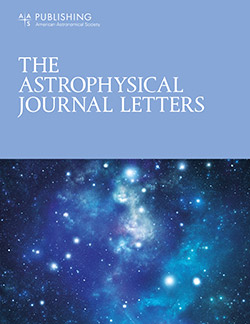The Gas Accretion Rate of Star-forming Galaxies over the Last 4 Gyr
IF 11.7
1区 物理与天体物理
Q1 ASTRONOMY & ASTROPHYSICS
引用次数: 1
Abstract
Abstract Star-forming galaxies are believed to replenish their atomic gas reservoir, which is consumed in star formation, through accretion of gas from their circumgalactic mediums (CGMs). However, there are few observational constraints today on the gas accretion rate in external galaxies. Here, we use our recent measurement of the scaling relation between the atomic hydrogen (H i ) mass M H I and the stellar mass M * in star-forming galaxies at z ≈ 0.35, with the relations between the star formation rate (SFR) and M * , and the molecular gas mass M Mol and M * , and the assumption that star-forming galaxies evolve along the main sequence, to determine the evolution of the neutral gas reservoir and the average net gas accretion rate onto the disks of star-forming galaxies over the past 4 Gyr. For galaxies with M * ≳ 10 9 M ⊙ today, we find that both M * and M H I in the disk have increased, while M Mol has decreased, since z ≈ 0.35. The average gas accretion rate onto the disk over the past 4 Gyr is similar to the average SFR over this period, implying that main-sequence galaxies have maintained a stable H i reservoir, despite the consumption of gas in star formation. We obtain an average net gas accretion rate (over the past 4 Gyr) of ≈6 M ⊙ yr −1 for galaxies with the stellar mass of the Milky Way. At low redshifts, z ≲ 0.4, the reason for the decline in the cosmic SFR density thus appears to be the inefficiency in the conversion of atomic gas to molecular gas, rather than insufficient gas accretion from the CGM.过去4个Gyr中恒星形成星系的气体吸积速率
恒星形成星系被认为是通过其环星系介质(cgm)的气体吸积来补充其在恒星形成过程中消耗的原子气藏。然而,目前对外部星系的气体吸积率几乎没有观测限制。在这里,我们使用我们最近测量的恒星形成星系中原子氢(H i)质量M H i与恒星质量M *在z≈0.35处的比例关系,恒星形成速率(SFR)与M *之间的关系,以及分子气体质量M Mol和M *之间的关系,并假设恒星形成星系沿主序演化。以确定在过去的4gyr中,中性气体储层的演化以及形成恒星的星系盘上的平均净气体吸积速率。对于今天M * > 10 9 M⊙的星系,我们发现盘中的M *和mh都增加了,而M Mol减少了,因为z≈0.35。在过去的4gyr中,圆盘上的平均气体吸积速率与这一时期的平均SFR相似,这意味着主序星系保持了稳定的H储层,尽管在恒星形成过程中消耗了气体。我们得到一个平均净气体吸积速率(在过去4 Gyr)≈6 M⊙yr−1的星系与银河系的恒星质量。在低红移(z > 0.4)时,宇宙SFR密度下降的原因似乎是原子气体向分子气体转化的效率低下,而不是CGM的气体吸积不足。
本文章由计算机程序翻译,如有差异,请以英文原文为准。
求助全文
约1分钟内获得全文
求助全文
来源期刊

Astrophysical Journal Letters
ASTRONOMY & ASTROPHYSICS-
CiteScore
14.10
自引率
6.30%
发文量
513
审稿时长
2-3 weeks
期刊介绍:
The Astrophysical Journal Letters (ApJL) is widely regarded as the foremost journal for swiftly disseminating groundbreaking astronomical research. It focuses on concise reports that highlight pivotal advancements in the field of astrophysics. By prioritizing timeliness and the generation of immediate interest among researchers, ApJL showcases articles featuring novel discoveries and critical findings that have a profound effect on the scientific community. Moreover, ApJL ensures that published articles are comprehensive in their scope, presenting context that can be readily comprehensible to scientists who may not possess expertise in the specific disciplines covered.
 求助内容:
求助内容: 应助结果提醒方式:
应助结果提醒方式:


